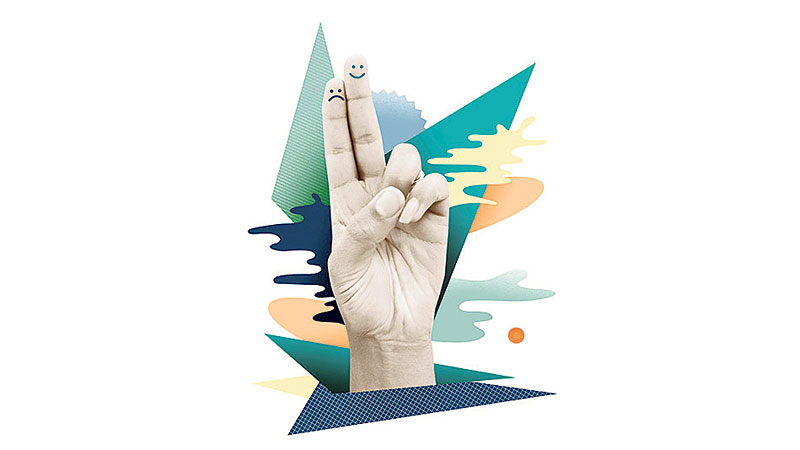
OR
Emotional minefield of adolescence
Published On: October 22, 2016 09:24 AM NPT By: Republica | @RepublicaNepal

The question amounted to this. “Why is my teenager so much more easily upset than as a child?”
The answer is because negotiating the adolescent passage is like crossing an experiential minefield with hidden emotional explosives buried all along the way. The young person has to watch their step, often reacting with unexpected and intense expressions of feeling for causes that can be hard for parents to fathom and tolerate.
So what follows is a list of some common feeling factors that parents might want to consider the next time a puzzling adolescent upset or outburst occurs.
SELF-CONSCIOUSNESS
For most young people, puberty (the 1 ½ to 3 year process of growth into sexual maturity) begins around early adolescence, during late elementary school and middle school, when the journey to young womanhood and young manhood begins. Not only can this hormone--driven change cause them to feel out of control of their body, it can also bring about an increase in self-consciousness, inadequacy, vulnerability toembarrassment, and moodiness, all made worse if one is socially teased or makes painful criticisms that put oneself down. More discomfort and sensitivity about one’s changing body from puberty are all part of the adolescent age.
FRUSTRATION
With the adolescent desire for more room to grow comes a greater need for immediate gratification. The young person seems ruled by a ‘Tyranny of Now’ in which blockage of any freedom can be painful to endure. At a time when the urge to grow is more intense, it can be intensely difficult to be made to slow down or to wait for or to do without what one wants. Not only can delay and denial frustrate a young person, it can also contribute to more prickly irritability and hasty impulsivity. Because urgency is an emotional imperative, more frustration is part of the adolescent age.
SADNESS
Adolescence begins with loss because the separation from childhood requires giving up and letting go much that was valued during one’s early years. Now the young person knows they can’t go home to that simpler sheltered time again, but must give up some beloved childish ways, interests, and even things, creating losses that can be sorely missed. Young people who are deeply suffering such grievous loss may be more prone to times of despondency, sorely conflicted about wanting and not wanting to grow up. More sadness over the loss of childhood attachments is part of the adolescent age.
ANGER
The desire to operate more independently and on one’s own terms causes the young person to be less tolerant of what parents say must and must not be done. In consequence, there is more resentment of parental rules and restraints: “Who gives you the right to make me more or stop me; you’re not the boss of the world!” Except, parents still dictate most terms on which the young person lives. More anger at the unfairness of adult authority is part of the adolescent age.
LONELINESS
Separating more from parents puts more pressure on finding and a family of friends to supplant companionship lost at home. In this community of peers, however, thepolitics of relationships create ever shifting associations. Constant vigilance is required to remain secure in one’s social circle because unlike parents, whose caring is committed, peer relationships are conditional on conforming to belong. There are times for most young people when friendships are broken, when one feels outsider, no longer fitting in, left out, rejected, unpopular, disconnected and alone. More loneliness both at home and in the world of peers is part of the adolescent age.
BOREDOM
Adolescents can have a conflicted relationship with freedom. When they feel entrapped in activities that have no positive meaning to them (like at school), they don’t have freedom enough; but when they feel empty of interest or purpose (like in vacation) they have more freedom than they know what to do with. On both counts, restless complaints about being “bored silly,” “bored out of my mind,” “bored to death” can result. Now doing something, anything, can feel better than having nothing to do, hence the increased vulnerability to joining equally bored peers in some impulsive escapade. More purposelessness and desperation from boredom is part of the adolescent age.
FAILURE
Most adolescents grow up with some positive expectations for themselves from themselves and from their parents. Not meeting these personal or parental goals or ambitions or hopes as sometimes happens can cause disappointment from which feelings of failure can follow. “I really let everybody down, myself included!” Judging oneself by one’s peers and not keeping up with their growth or accomplishments can also disappoint. “I didn’t do as well as my friends.” More feelings of disappointment from actual or comparative failure are part of the adolescent age.
ANXIETY
Passing through the door of early adolescence, the young person enters an immeasurably larger field of play than childhood where daunting older experiences await and many social dangers abound. Growing up is a scary business, and most young people encounter frightening challenges and worry with scary possibilities along the way. This is why adolescence is often an act of courage. Times of feeling afraid, coping with threats, taking risks, and facing fears are all part of the journey. More anxiety at real and imagined dangers are part of the adolescent age.
(Psychology Today)
You May Like This

The year of Trump?
Trump’s temperament ranks low on the scales of emotional and contextual intelligence that made Roosevelt or Bush successful presidents ... Read More...

Left-Sided Hugs are More Emotional: Study
If you are feeling emotional, you are more likely to embrace others from the left side than from the right,... Read More...

Emotional rollercoaster
The beautiful thing about literature is that it captures all variations of emotions. We like stories because they connect us... Read More...

Just In
- Home Ministry directs recalling security personnel deployed for personal security against existing laws
- Fake Bhutanese refugee case: SC orders continued pre-trial detention for seven individuals including former DPM Rayamajhi
- ADB Vice-President Yang pays courtesy call on PM Dahal
- PM Dahal, Chairman of CIDCA Zhaohui hold meeting
- MoFAGA transfers 8 under secretaries and 11 section officers (with list)
- PM Dahal arrives in Morang
- DDC pays Rs 480 million dues to farmers
- Police arrest seven Indian nationals with 1.5 kg gold and Rs 14.3 million cash

















Leave A Comment